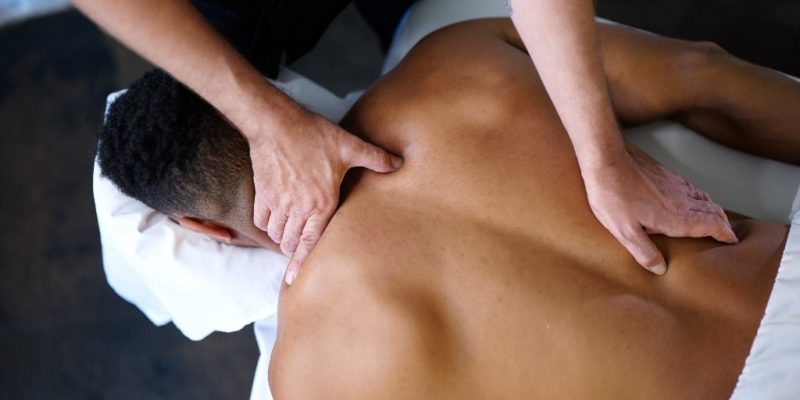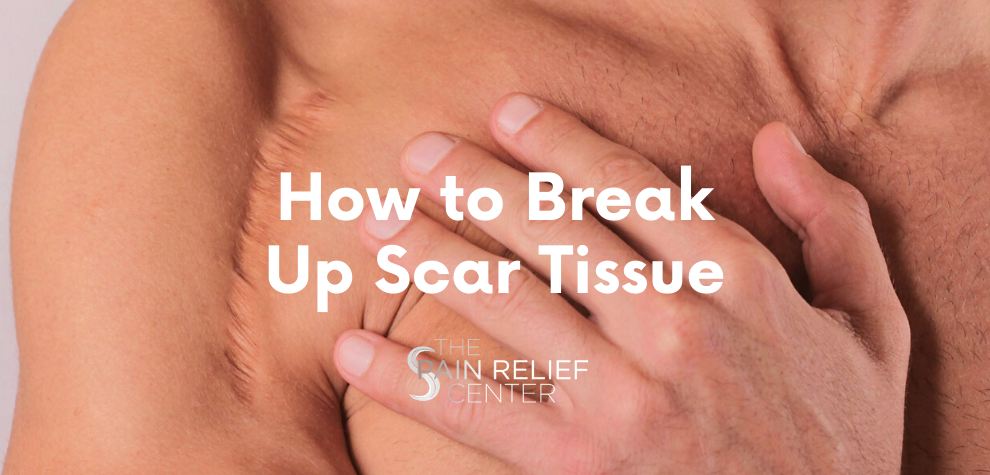If you’re recovering from any major injury or surgery, you will likely notice the development of scar tissue throughout your healing. While scar tissue is a good thing because it means your tissues are healing, it can also cause lots of pain, discomfort, and loss of mobility. Thankfully, we live in a time where there are numerous treatments for almost any kind of ailment, including painful scar tissue. If you’re wondering how to break up scar tissue so that you can get on with your pain-free life, call The Pain Relief Center today at 214-709-1904 and we can help.
What is Scar Tissue?
If you suffer a deep cut or scrape on your skin from an accident or a surgery, scar tissue develops because your body is trying to repair the tissue. Basically, scar tissue is just a collection of collagen cells that cover an old wound to ultimately prevent infection. All healthy tissue produces collagen fibers in the skin at the cellular level to maintain elasticity and heal injured tissues.
Types of Scar Tissue
There are many different types of scar tissue that can appear over the course of the healing process following an injury. The most common types of scar tissue include keloids, hypertrophic scars, contracture scars, atrophic scars, adhesions, stretch marks, and flat scars.
Keloids
Keloids are thick, bumpy, and red scars that can form after any kind of injury to the skin. This type of scar tissue most commonly appears on the chest, shoulders, and upper back. Additionally, keloids more commonly appear on darker skin.
Hypertrophic Scars
This type of scar tissue is possibly the most common following some kind of cut or scrape on the skin. Hypertrophic scars are also thick and raised on the skin, but not near as much as keloids. Additionally, hypertrophic scars can fade over time without any treatment.
Contracture Scars
This type of scarring is most common following a burn injury. Contracture scars are generally described as tight on the skin which can therefore affect normal mobility. This is especially the case if contracture scars develop on large areas of the body.
Atrophic Scars
Many healthcare professionals call these kinds of scars “depressed scars” as well. They generally look like small holes or pits in the skin and are most commonly caused by cystic acne or chickenpox. Atrophic scars appear most often on the face and can become more and more noticeable as a person ages. This is because the skin naturally loses elasticity and collagen cells over time.
Adhesions or Internal Scar Tissue
Scars don’t just appear externally on the skin. Scars form internally too. Internal scar tissue develops usually due to surgery, muscle tears, or broken bones. Adhesion formation is a crucial part of healing from any kind of injury so that your body can remain as strong and healthy as possible.
Stretch Marks
Another very common type of scar is stretch marks. Stretch marks happen when people either gain or lose weight too fast, eventually causing the development of scar tissue. The parts of the body that generally grow or shrink rapidly are the stomach, breasts, thighs, and upper arms. Therefore, stretch marks generally appear in those areas of the body especially after pregnancy, puberty, extreme weight gain, or extreme weight loss.
Flat Scars
These types of scars are just how they sound: flat. They often look pink, red, or purple at the beginning of the healing process. But they eventually become lighter and blend in with your normal skin color.
Common Causes of Scar Formation
As previously stated, there are many different causes of scar tissue formation, including:
-
Cuts and scrapes on the skin
-
Surgery
-
Cystic acne and acne picking/popping
-
Infection
-
Chickenpox
-
Piercings
-
Tattoos
-
Burns
-
Muscle sprains and strains
-
Broken bones
Symptoms of Painful Scar Tissue
Each type of scar will feel different depending on the person, the cause of the scar, and more. Some people don’t feel any pain or discomfort around their scars, and some people are physically and psychologically tormented by their scars for many years. The most common symptoms of painful scar tissue include:
-
Constant itching and burning around the scarred area
-
General pain around the scarred area
-
Lack of mobility, especially if the scar tissue covers a large area of the body or the scar tissue developed around large muscles or bones
-
Redness, swelling, and possibly a warm feeling in the affected area
Is Scar Tissue Permanent?
For many people, internal and external scar tissue isn’t permanent. Once a scar forms and becomes fully healed, it will then undergo remodeling so that the new tissue can tolerate daily physical stress.
What is Scar Tissue Remodeling?
When you think of remodeling, you may think of a house that undergoes significant structural and aesthetic changes. Scar tissue remodeling is a similar concept in that the new, healthy tissue changes through stretching and pulling on the affected area. This allows the collagen cells to return to normal. Additionally, scar tissue remodeling is crucial for the previously injured tissue to regain normal range of motion and promote strength. The remodeling process can take six to eight weeks depending on the person and the original injury. However, if scar tissue doesn’t remodel as it should, you could potentially lose your range of motion and experience excess pain.

How to Break Up Scar Tissue With Various Treatments
Now onto the information we’ve all been waiting for: how to break up scar tissue after an injury or a surgery. There are many manual therapy techniques out there to achieve this. It all depends on your type of scarring and what your healthcare provider feels is best for you.
Physical Therapy
Physical therapy can certainly help the pain and discomfort you may be experiencing from your scarring. A physical therapist can perform scar tissue massage, especially if they see that your scars haven’t remodeled as they should. Massaging scar tissue can potentially promote the remodeling process, therefore reducing pain and improving range of motion over time.
However, scar tissue massage can also be unhealthy, especially if the scar isn’t fully healed. If the scarred tissue is still damaged, scar massage techniques can actually delay healing. Therefore, it’s crucial for you to talk with your physical therapist about whether massage is the best type of scar management for you.
Cross Friction Massage
Another scar massage technique is cross friction massage, which may also promote remodeling. If you choose this type of scar tissue massage, your physical therapist will use one or two fingers to knead around the scar line. Not only can cross friction massage assist remodeling, but it can also keep the collagen fibers properly aligned so that the scar can heal and turn into healthy tissue. Physical therapists may also recommend cross friction massage for tendonitis, muscle strains, and ligament sprains.
Myofascial Release
Another type of scar tissue massage is myofascial release. Basically, physical therapists will slowly knead around the scars, similarly to the other two massage techniques. However, with this technique, physical therapists will generally search for fascia, which are tissue restrictions. They can then use their hands to improve movement within the injured tissue.
Stretching and Flexibility Exercises
If you decide to go the physical therapy route, your physical therapist will likely instruct you to incorporate stretching and flexibility exercises into your daily routine. Similarly to scar tissue massage, simple stretches can promote remodeling, pain relief, and improved mobility.
Laser Therapy
Another way of breaking up scar tissue is through laser therapy. Laser therapy can promote the growth of new collagen cells which can decrease pain, improve range of motion, relieve minor itching, and even fade the scarring over time. It’s important to note, though, that it’s unlikely that this technique will make the scars completely disappear.
Corticosteroid Injections
Another technique that can manage scar tissue is corticosteroid injections which can lead to less pain. However, the downside to these injections is that they can damage surrounding tissues, therefore causing pain and hindering overall healing. Make sure to discuss this treatment in-depth with your physical therapist or healthcare provider before trying it.
Extracorporeal Shockwave Therapy (ESWT)
This can be a great treatment for breaking up scar tissue. Shockwave therapy works by using impulse pressure waves to break apart damaged tissue at the cellular level. Additionally, this treatment can increase blood flow and therefore promote quicker healing within the damaged tissue.
Surgery
Surgery is a last resort if other treatments fail to reduce pain, improve mobility, and improve the scar’s appearance. If you choose this route, your surgeon will completely remove the damaged tissue and possibly even replace it with skin from another body part. If you’re suffering from excessive adhesions surrounding the muscles or bones that don’t heal with other non-invasive treatments, then surgery may be the best option for you.
There are risks with every surgery, so it’s best to discuss that with your doctor before going under the knife. Additionally, it’s important to remember that surgery requires significant recovery time compared to the other scar tissue treatments listed.
Call The Pain Relief Center Today
If you or someone you love is suffering from painful scar tissue after an injury or a surgery, doctors at The Pain Relief Center will recommend the best course of treatment specifically for breaking up scar tissue. Call 214-709-1904 for pain relief, compassion, and care from our Dallas pain management doctors.


